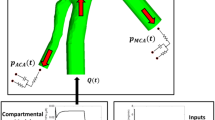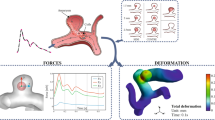Abstract
The success of clot thrombolysis very much depends on efficient clot permeation with blood plasma carrying the thrombolytic agent. In this paper clot permeation was studied by dynamic magnetic resonance imaging (MRI) on artificial non-occlusive blood clots inserted in an artificial circulation system filled with blood plasma to which an MRI contrast agent was added. The MRI results revealed that clot permeation is much faster and more efficient at the entrance of the flow channel across the clot. Clot permeation with fluid was simulated numerically as well. The simulation was based on numerical solution of Navier–Stokes equations for the flow in the channel and within the clot. The clot was considered as a porous material with known permeability and porosity. Based on the calculated velocity profiles, concentration profiles of fluid in the clot were modelled. These agreed well with the MRI results. The presented model of clot permeation with fluid may also serve as a useful extension to numerical modelling of dissolution of non-occlusive blood clots during thrombolytic therapy.




Similar content being viewed by others
References
Kandarpa K (1999) Catheter-directed thrombolysis of peripheral arterial occlusions and deep vein thrombosis. Thromb Haemost 82:987–996
Blinc A, Francis CW (1996) Transport processes in fibrinolysis and fibrinolytic therapy. Thromb Haemost 76:481–491
Carr ME Jr, Shen LL, Hermans J (1977) Mass-length ratio of fibrin fibers from gel permeation and light scattering. Biopolymers 16:1–15
Collen D (1999) The plasminogen (fibrinolytic) system. Thromb Haemost 82:259–270
Hennig J, Nauerth A, Friedburg H (1986) RARE imaging: a fast imaging method for clinical MR. Magn Reson Med 3:823–833
Kucher N, Goldhaber SZ (2006) Risk stratification of acute pulmonary embolism. Semin Thromb Hemost 32:838–847
Landau LD, Lifshitz EM (1995) Fluid mechanics, 2nd edn. Butterworth-Heinemann, Oxford
Nichols WW, McDonald DA, O’Rourke MF (2005) McDonald’s blood flow in arteries: theoretical, experimental, and clinical principles, 5th edn. Hodder Arnold; distributed in the United States of America by Oxford University Press, New York
Pleydell CP, David T, Smye SW, Berridge DC (2002) A mathematical model of post-canalization thrombolysis. Phys Med Biol 47:209–224
Sakharov DV, Rijken DC (2000) The effect of flow on lysis of plasma clots in a plasma environment. Thromb Haemost 83:469–474
Sersa I, Tratar G, Mikac U, Blinc A (2007a) A mathematical model for the dissolution of non-occlusive blood clots in fast tangential blood flow. Biorheology 44:1–16
Sersa I, Vidmar J, Grobelnik B, Mikac U, Tratar G, Blinc A (2007b) Modelling the effect of laminar axially directed blood flow on the dissolution of non-occlusive blood clots. Phys Med Biol 52:2969–2985
Tratar G, Blinc A, Strukelj M, Mikac U, Sersa I (2004) Turbulent axially directed flow of plasma containing rt-PA promotes thrombolysis of non-occlusive whole blood clots in vitro. Thromb Haemost 91:487–496
White-Bateman SR, Schumacher HC, Sacco RL, Appelbaum PS (2007) Consent for intravenous thrombolysis in acute stroke: review and future directions. Arch Neurol 64:785–792
Wootton DM, Popel AS, Alevriadou BR (2002) An experimental and theoretical study on the dissolution of mural fibrin clots by tissue-type plasminogen activator. Biotechnol Bioeng 77:405–419
Author information
Authors and Affiliations
Corresponding author
Additional information
Regional Biophysics Conference of the National Biophysical Societies of Austria, Croatia, Hungary, Italy, Serbia, and Slovenia.
Rights and permissions
About this article
Cite this article
Grobelnik, B., Vidmar, J., Tratar, G. et al. Flow-induced permeation of non-occlusive blood clots: an MRI study and modelling. Eur Biophys J 37, 1229–1233 (2008). https://doi.org/10.1007/s00249-008-0342-8
Received:
Revised:
Accepted:
Published:
Issue Date:
DOI: https://doi.org/10.1007/s00249-008-0342-8




